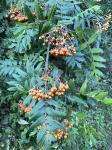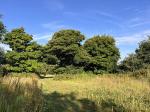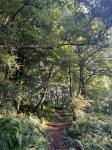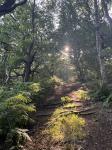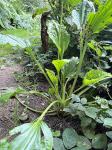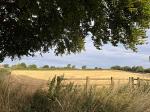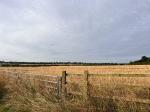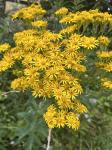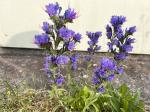Brayton Barff Through the Seasons.
Set in the Vale of York, South West of the market town of Selby and between the villages of Thorpe Willoughby and Brayton, lies Brayton Barff, a sandstone Hill approximately one hundred and fifty feet in height which was formed by glacial movement during the last Ice Age. It is a significant landmark in an otherwise flat landscape.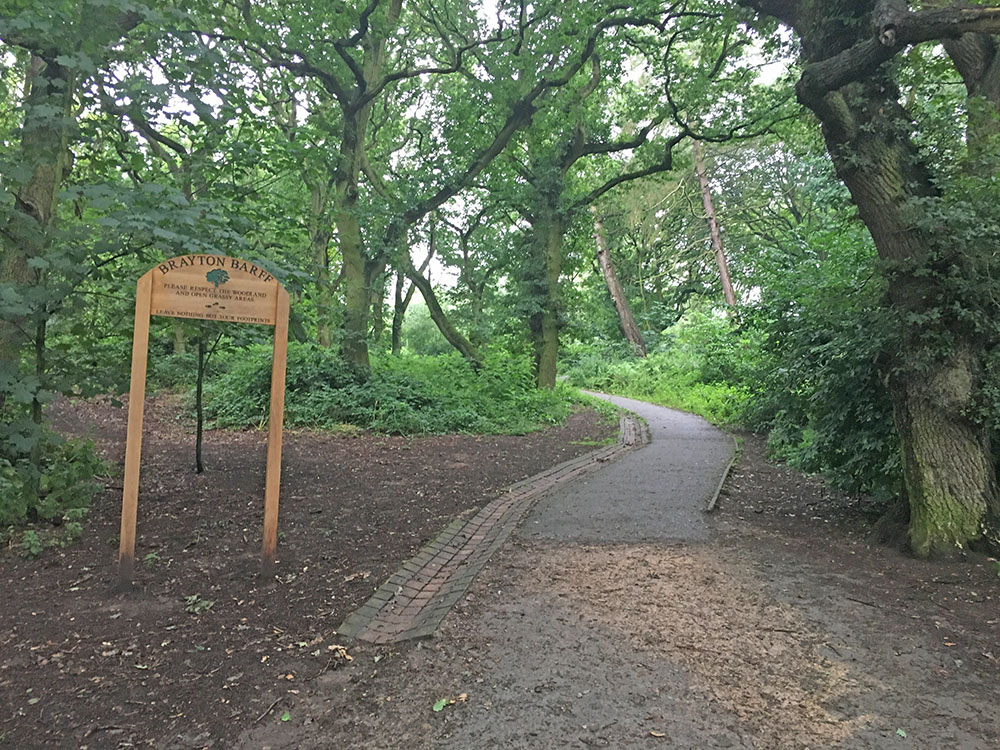
Today the site is primarily owned by Yorkshire Water with Selby District Council owning a small patch of the land adjacent to the A63 Selby bypass. A large underground reservoir occupies the centre of the site which delivers water to around 4.7 million customers throughout Yorkshire.
Within the Barff woodland over 40% of the trees are Sessile Oak which are generally found in semi natural woodlands in the north of the country. These trees are so called because its acorns are not held on stalks, like those of the English Oak (Pedunculate), but attached directly to the outer twigs. There are also several English Oak trees as well as some cross-hybrid oaks. These trees are known to support many species of flora and fauna, invertebrates, mosses, lichen and fungi.
During the Victorian times it is thought that the shipbuilders on the east coast would come over to the Barff for selected cuts of timber to build their sea going vessels.
The Barff also has a variety of other trees including Silver Birch, Beech, Sycamore, Holly, Rowan, Scots Pine, Alder, Hawthorne and European Larch. There are also several Yew, Willow, Hazel, Horse Chestnut and Wych Elm. As with similar woodlands there are a variety of bushes, including Honeysuckle, Elderberry, Gorse, Broom and Buddleia.
The history of Brayton Barff is quite vague, apparently during 1803 a beacon was lit on the Barff when the country was threatened with an invasion by Napoleon. In May 1935, to celebrate King George V's Silver Jubilee, a Bonfire was lit on the Barff as part of the celebrations.
Early issues of Ordnance Survey Maps dated 1903 clearly show a rifle range on the Barff, extending out to Mill Lane. During the 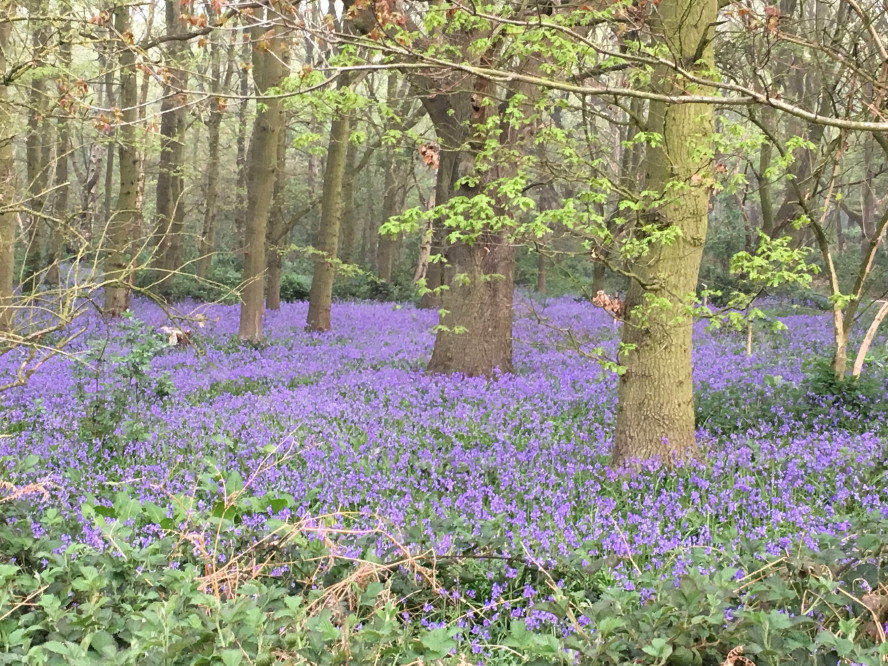
Between 2001 – 2004 the A63 Selby bypass, 10km twin lane single carriageway was constructed which severed the South West corner of the Barff, adjacent to Selby Golf Course and resulted in a slight redesign of several holes on the golf course. Wooden fencing was erected as a result of this new road running alongside of the Barff and a footbridge constructed over the ‘new road’ following the line of the Bridal way which extends from Mill Lane. Around 2005/2006 a definite 2metre wide limestone aggregate footpath was laid forming a circular path around the outer edges of the woodland. This footpath is approximately 1.2 miles in length and takes about 30 minutes to circumnavigate at a leisurely pace.
In 2012 the Barff was declared an Ancient Oak Woodland and as such throughout 2012 and 2013 significant work had been carried out by the relevant agencies to cut and remove large swathes of non-native trees, creating at that time huge scars on the landscape. Some three years later the planting of the native trees have become well established and are flourishing. Ongoing maintenance work on the footpath around the bottom of the Barff was completed during the Summer of 2016.
A second phase of woodland maintenance commenced during the Autumn of 2019 with the removal of many old and diseased trees and the cutting back of the Gorse and Broom bushes, especially adjacent to the ‘bypass trail’, this work continued through till March 2020 with re planting continuing into April 2020.
Brayton Barff is a popular site for walkers and bird watchers alike and a path circling the outer perimeter of the Barff makes a pleasant thirty minute walk, giving views looking over towards Selby and the village of Brayton as well as the power stations of Drax and Eggborough..jpg)
For the early risers it is a great place to see some stunning sunrises over the villages of Brayton looking towards Drax Power Station, the same with the Sunsets looking over towards Eggborough and Monk Fryston.
The Barff changes with the Seasons and every visit can reveal something new, the woodland is a haven for wildlife. Records show that since 1982 one hundred and twelve species of bird have been seen in the woodland and at least 40 of those have bred here, including Tawny Owl, Buzzard, Green Woodpecker, Spotted Flycatcher, Goldcrest and Nuthatch to name just a few. On average over 70 species of bird are recorded each year. Further details of the bird life on the Barff can be found on the Brayton Barff Group Facebook page, especially the posts from Derek Cooper. Today ‘The Friends of Brayton Barff group’ led by Derek and a small team of volunteers help keep and maintain the cleanliness of the site as well as recording the wildlife and bird sightings.
The Barff is also home to fifteen different species of mammals, including Muntjac Deer, Pipistrelle Bat, Fox, and Field Vole.
Over eighty species of plant and wildflowers have been recorded, included Bee Orchid, Northern Marsh Orchid, Wood Anemone, Marsh Ragwort, Bluebell, White Bluebell, Bittersweet and Purple and White Foxgloves. Over twenty species of Butterfly have been recorded, including Marbled White, Brown Angus, Speckled Wood, Comma and Brimstone.
During the Autumnal months fungi thrives in this woodland environment, species including Fly Agaric, Beefsteak Tree Fungi, Chicken of the Wood, Sulphur Tufts, Stinkhorn, Ink cap, Puffballs and Hoof Bracket are just some of the many varieties that can be found here.
Click on the galleries shown below to expand the albums.
July 2024
Sunday 7th July. Having been away on holiday this last week, this morning was my first visit to the Barff this month with my four-legged companions Meg and Gracie. I was surprised to read whilst I was away that some parts of the country have already seen a months’ worth of rainfall in the first week of July, what a start to a UK summer. It was a dull and overcast start to the day this morning, 12c at 6.00am as we arrived on the Barff, thundery showers were forecast for later in the day, but other than a couple of light showers late afternoon that was it. I was disappointed to see that the undergrowth around the perimeter footpath has not yet been cut back, it is getting very narrow in places due to the Nettles, some of which are standing at well over six feet tall in places. Patches of flowering Himalayan Balsam are popping up around the woodland amongst the Ferns and Brambles, it is reassuring to know that our team of volunteers (Friends of Brayton Barff) are meeting every Monday evening to tackle this invasive plant. It is such a shame that the owners of the Barff cannot find the time to look after and manage this ancient woodland.
The Barff summit is quite a colourful picture with patches of Yellow Ragwort coming into flower along with creeping Buttercup, St John’s Wort and Creeping Cinquefoil forming a yellow blanket of colour on the meadow floor.
Lots of birdsong filled the air, Chiffchaff, Wren, Song Thrush and Blackcap all busily singing their heads off this morning.
Monday 8th July, was an absolutely beautiful morning, 12c, no breeze, it was a dry, bright, and sunny morning, one of those days where I could have stayed up here all day watching the wildlife and spotting new wildflowers. Birdsong was very vocal from the Blackcap, Chiffchaff, Robin and Wren. Creeping Thistles are flowering in vast numbers especially on the top meadow. Spear Thistles are beginning to flower too with the purple florets bursting out of the buds. The top meadow looks a picture with flowering Ragwort, Creeping Cinquefoil, Self-Heal and lots of Clover. Unfortunately, the main perimeter footpath remains heavily overgrown.
Tuesday 9th July, what a contrast to yesterday morning, with very heavy rain which started in the early hours and continued till mid-afternoon. Full waterproofs for this morning’s walk, despite the rain it was quite humid at 13c. Birdsong was very muted today, I think they were keeping well wrapped up in the shelter of their nests and hiding holes, just the constant cooing of the Woodpigeon to keep us company on this morning’s walk. It was good to see both verges had been cut back around the perimeter footpath, restoring them back to their full width, no more nettled hands or forearms for the next few weeks at least.
Thursday 11th July. Heavy overnight rain made this morning’s walk a very wet one, much to the delight of Meg and Gracie. The rain had stopped by the time we arrived on the Barff, but the grass and ferns were exceptionally wet. Meg in particular loves rolling and sliding on wet grass, although dull, cloudy and overcast it felt a little cooler than yesterday at 13c with a fresh westerly breeze. Birdsong was somewhat muffled again this morning, probably due to the early morning rain.
Friday 12th July. A Lovely dry bright sunny morning, 13c, humid with a light westerly breeze. It was good to see the Winter wheat planted in the fields adjacent to the woodland was turning into a lovely yellow golden colour, it will be several weeks before it is harvested, let’s hope it gets a little dryer. The St John’s Wort on the top meadow is being outgrown by the Yorkshire Fog grass.
Saturday 13th July a dull, cloudy and overcast morning, rain forecast mid-morning. It was very humid again at 13c, though the cool westerly breeze and the lack of sun kept the temperature down. It was nice to hear the Buzzard calling this morning in the woodland, close to the old pump house. We walked along the bypass trail this morning down to Mill Lane and across the bypass returning to the Barff along the opposite side of the road. Huge swathes of Rosebay Willowherb were in flower, swaying gently in the breeze as were flowering Creeping Thistle, the gate entrance to the wheat field on the left was a colourful picture of wildflowers including Ox Eyed Daisies and Red Poppies. Following the trail on the opposite side of the Bypass, Meadow Crane’s bill added a splash of colour amongst the long Yorkshire Fog Grass. It was nice to see several patches of Blueweed on the footbridge, Spreading Hedge Parsley was shooting up all over the place as is the flowering Heal all. The top meadow is still looking colourful with huge swathes of yellow flowering St John’s Wort, Creeping Buttercup and Creeping Cinquefoil. Birdsong was quiet this morning, Song Thrush, Garden Warbler, Wren and Robin all sounding a little muffled, they were probably preparing themselves for the rain which was forecast to arrive later in the morning.
It was good to see that someone had finally cut down the oak tree branch (close to the service road entrance) which had fallen several years ago but hadn’t detached itself from the rest of the tree, at least you can now walk under the tree without the hazard of it suddenly falling on you!
Sunday 14th July, we woke up to a very wet morning with heavy rain falling, it was a little cooler at 12c with a light north westerly breeze. Wren, Blackcap and Chiffchaff were all very vocal, despite the heavy rain. Hedge Parsley is flowering all around the woodland along with patches of Red and White Campion.
Monday 15th July, a dry bright and humid morning, 15c. It was exceptionally wet underfoot from the overnight rain. Lots of birdsong with Wren taking the lead, along with the Song Thrush and Carrion Crow, the soothing cooing of the Wood Pigeon completing this morning’s line up. The Rowan berries are beginning to ripen nicely, turning a pale orange colour, whilst the Elderberry bushes are just beginning to turn to berries, certainly several weeks behind the Rowan trees. I noticed a large number of new Bank vole holes today. I don’t know what has happened to the Grey Squirrel population of late, they along with the Brown Rats seem to have taken a very long holiday from the woodland. As well as the new vole holes I am also noticing small clusters of Puffball fungi growing on the woodland floor, The Creeping Cinquefoil on the top meadow is being swamped by the Yorkshire Fog grass.
Tuesday 16th July. Another wet, damp and soggy morning, 15c, very humid, despite wearing waterproofs I was as wet on the inside as well as the outside this morning, though being full of cold didn’t help the matter this morning. Despite the yellow rain warning for our area of North Yorkshire we escaped the rain till late afternoon, with the sun coming out early morning and the temperature gauge reaching 21C by 2pm.
Wednesday 17th July, what a contrast to yesterday morning. Today was dry, bright and very sunny, 15c at 7.00am, with a beautiful blue cloudless sky. The ground was very wet and slippery in places. Birdsong was a little muted in places but the Song Thrush, Wren and Chiffchaff, accompanied by the Wood Pidgeon were all on good form. The Spear Thistles are beginning to flower around the woodland, Creeping Thistle has been in flower for several weeks now. Yorkshire Fog grass is shooting up on the top meadow and beginning to smother the St John’s Wort and ‘Heal all’. Bramble runners are beginning to be a problem in all areas again growing several inches in a twenty-four-hour period. In fact the patch of Brambles on the top meadow on the top of Tap Hill are completely out of control now and swamping everything in its wake. The council/waterboard will need some substantial cutting equipment to get them back to a manageable level to enable the wildflowers underneath to thrive.
Wednesday 17th July, what a contrast to yesterday morning. This morning was a bright beautiful sunny morning 15C at 7.00am.
Thursday 18th July, a touch of summer has returned to the woodland, another bright sunny morning/day 17c at 7.30am, the temperature actually rose to 25c by late afternoon. Birdsong was quite muted, this morning, though it was good to hear the Buzzard calling in the woodland. I watched a small family of Grey Squirrels have a bit of a dispute amongst themselves, chattering and screeching at each other. They have been very quiet of late with very few sightings.
Friday 19th July, another bright and beautiful morning, 17c at 6.45am, rising to 27c by late afternoon. Wren, Chiffchaff, Blackcap and Chaffinch were a little more vocal than yesterday morning. It was very humid around the woodland. The sweet scent of the Honeysuckle lingering along the top track above Tap Hill. The family of Grey Squirrels were still at it this morning, chattering away to themselves.
Saturday 20th July, a beautiful morning, 18c at 7.00am, very warm and humid, no wind, birdsong was very muted. Good to see the wheat field at the junction with Mill lane had been harvested. Broadleaf Plantain has suddenly burst into life, some standing at well over 30cm in heigh, Blueweed seems to be flourishing on the footbridge over the bypass, and Rowan berries are starting to ripen.
Sunday 21st July, a lovely bright and sunny morning, 14c, much cooler than of late, Buzzard very vocal round by the old pump house. Birdsong quite muted again, Chiffchaff, Wren, Blackcap and Song Thrush quite vocal though. Whilst I stopped to photograph some Evening Primrose in the field adjacent to Mill Lane and the Bypass, I disturbed a pair of Roe Deer, who went running deeper into the field. The summit of the Barff is quite a picture at the moment with the variety of wildflowers in flower, although many are being dwarfed by the Yorkshire Fog Grass, ‘Heal all’ is still thriving, Common Ragwort is flowering nicely all around the Barff, Creeping Thistle is flowering along the edge of the massive invasion of Bramble on the top summit, the tiny florets of ‘European Centaury’ are beginning to open up, Red and White Clover, Creeping Buttercup and St John’s Wort to name but a few.
Monday 22nd July, what a contrast to yesterday morning, the heavy overnight rain made it very wet underfoot and certainly if you ventured away from the main perimeter footpath your trousers and socks would be wet through in seconds. Although it wasn’t raining on our walk, it was extremely humid at 15c at 7.00am. As the month draws to a close the birdsong is quieting down and not as vibrant as it was at the start of July. Woodpigeon and Wren were quite vocal though around the woodland today. The Lesser Burdock which has been growing for many months now is just beginning to flower. Common Ragwort continues to provide ample colour with its bright yellow florets enticing insects and moths of all shapes and sizes, it is the favourite plant for the Cinnabar Moth and records have shown that it is the most visited flower in the uk, with more than 200 species of invertebrate recorded on it.
Tuesday 23rd July was another lovely dry morning, 16c, with a light westerly breeze which kept the temperature down a little. It was nice to see some tiny acorns starting to appear on the mature Oak trees, Oak trees do not start to produce fruit (Acorns) until they reach the age of between 20 – 30 years of age, let’s hope it is going to be a good and fruitful year for them. I read an interesting report in this morning’s paper saying that Butterfly numbers are at a record low. Conservators carried out a survey recently ‘the butterfly count’ and recorded seeing half the number of butterflies than seen at the same time last year. Experts in butterfly conservation are saying that the unusually wet and windy Spring, coupled with colder than usual temperatures so far this Summer could be a factor. The findings reflect exactly what we are noting on the Barff at this time. While they say there could be a late emergence of the insects if there is a prolonged sunny spell, numbers are currently at the lowest recorded in the 14-year history of ‘The Butterfly count’. The report goes on to say that it is not just the weather problem, with 80% decline in butterfly species since 1970, but issues such as habitat loss, pesticides, and climate change all taking their toll and because numbers are already depleted, they are less resistant to bad weather. Butterflies need dry, and warm conditions to fly around and mate. If the weather does not allow this then there will be fewer opportunities for the Butterflies to breed, and the lack of them now is likely to have a knock-on effect of our wet and dreary Spring and early Summer, which is just what we are noting on the Barff.
Wednesday 24th July. Another lovely dry morning, 16c, slightly overcast, I watched a Grey Squirrel busily scurry across the perimeter footpath this morning, I haven’t seen any Greys for a while now so that was good to see. We headed up to the top meadow this morning, some of the Spear Thistles up there along the top fence are standing well over seven feet in height, quite a size, and coming into flower, their bulbous seed heads the size of a golf ball.
Thursday 25th July. A lovely dry morning, 18c at 8.00am as we came off the Barff, it was a very quiet morning. Intermittent birdsong from the Wood Pigeon, Wren, Chiffchaff, Robin and Crow. We ventured up onto the top meadow again this morning to have a look at the wildflowers, the Fog grass is shooting up and dwarfing many of the smaller plants, including Smooth Hawksbeard, Birds Foot Trefoil, Meadow Vetching and Self Heal. Common Ragwort and Rosebay Willow Herb are providing lots of colour and nutrients for the insects. The Bramble Patch is now invading the track from the top of Tap Hill across to the service road and if kept unmanaged will soon be overgrown closing the path completely, just as it has done down the Tap Hill toboggan slope.
I’ll sign off here as we are driving down to Kent for a few days, will be back up in Yorkshire though for the beginning of August.
|

